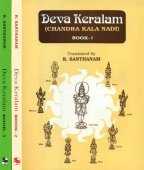Trailokya: 22 definitions
Introduction:
Trailokya means something in Buddhism, Pali, Hinduism, Sanskrit, Marathi, Hindi. If you want to know the exact meaning, history, etymology or English translation of this term then check out the descriptions on this page. Add your comment or reference to a book if you want to contribute to this summary article.
Alternative spellings of this word include Trailoky.
In Hinduism
Purana and Itihasa (epic history)
Source: archive.org: Shiva Purana - English TranslationTrailokya (त्रैलोक्य) refers to the “three worlds”, as mentioned in the Mahāmṛtyuñjaya-mantra, according to the Śivapurāṇa 2.2.38.—Accordingly, as Śukra related the Mahāmṛtyuñjaya to Dadhīca:—“We worship the three-eyed lord Śiva, the lord of the three worlds (i.e., trailokya), the father of the three spheres, the lord of the three guṇas. Lord Śiva is the essence, the fragrance of the three tattvas, three fires, of every thing that is trichotomised, of the three worlds, of the three arms and of the trinity. He is the nourisher. In all living beings, everywhere, in the three guṇas, in the creation, in the sense-organs, in the Devas and Gaṇas, he is the essence as the fragrance in a flower. He is the lord of Devas. [...]”.
Source: Cologne Digital Sanskrit Dictionaries: The Purana IndexTrailokya (त्रैलोक्य).—Jana, Tapa and Satya lokas; durable worlds.*
- * Viṣṇu-purāṇa II. 7. 19.
Trailokya (त्रैलोक्य) (“three worlds”) refers to Bhūta (past), Bhavya (future) and Bhavat (present), according to the Brahmāṇḍa-purāṇa 2.38. Accordingly, “The Indras of all the Manvantaras of the past (bhūta), present (bhavat) and future (bhavya) should be known as having equal (similar) characteristic features. [...] It is remembered by the Brāhmaṇas that Bhūta, Bhavya and Bhavat are the three worlds (trailokya). This Bhūrloka (Earth) is remembered as Bhūta; the Antarīkṣa (Atmosphere) is remembered as Bhavat. The Diva (Heaven) is remembered as Bhavya”.

The Purana (पुराण, purāṇas) refers to Sanskrit literature preserving ancient India’s vast cultural history, including historical legends, religious ceremonies, various arts and sciences. The eighteen mahapuranas total over 400,000 shlokas (metrical couplets) and date to at least several centuries BCE.
Shaktism (Shakta philosophy)
Source: Google Books: Manthanabhairavatantram1) Trailokya (त्रैलोक्य) refers to the “three worlds”, according to the Kulapañcāśikā, an unpublished text attributed to Matsyendranātha teaching secrecy (quoted by Kṣemarāja in his commentary on the Śivasūtra 3.26).—Accordingly, “Even though they know the three times and are capable of attracting the three worlds [i.e., trailokya-ākarṣaṇa], they conceal their practice and guard (the teaching) that has come from (their) Kula. Seeing one who does not have manifest outer signs (of his attainment and practice) the rays (of the deity) converge (upon him). O beloved, they are most hidden and so do not approach one who bears outer signs”.
2) Trailokya (त्रैलोक्य) refers to one of the eight Bhairavas (bhairava-aṣṭaka) associated with Pūrṇagiri or Pūrṇapīṭha (which is located in the northern quarter), according to the Manthānabhairavatantra, a vast sprawling work that belongs to a corpus of Tantric texts concerned with the worship of the goddess Kubjikā.—[...] The eight Bhairavas: Candrapūrṇa, Tṛpta, Triśira, Triśikha, Trimūrti, Trailokya, Ḍāmara, Mārtaṇḍa.

Shakta (शाक्त, śākta) or Shaktism (śāktism) represents a tradition of Hinduism where the Goddess (Devi) is revered and worshipped. Shakta literature includes a range of scriptures, including various Agamas and Tantras, although its roots may be traced back to the Vedas.
Pancaratra (worship of Nārāyaṇa)
Source: University of Vienna: Sudarśana's Worship at the Royal Court According to the AhirbudhnyasaṃhitāTrailokya (त्रैलोक्य) refers to the “three worlds”, according to the Ahirbudhnyasaṃhitā, belonging to the Pāñcarātra tradition which deals with theology, rituals, iconography, narrative mythology and others.—Accordingly, “Then he shall obtain land extending as far as the whole earth with [all of its] cities. Siddhas, Gandharvas and Dānavas will be subdued forever. On earth he will rule over the entire realm of the Three Worlds (trailokya-rājya). [...]”.

Pancaratra (पाञ्चरात्र, pāñcarātra) represents a tradition of Hinduism where Narayana is revered and worshipped. Closeley related to Vaishnavism, the Pancaratra literature includes various Agamas and tantras incorporating many Vaishnava philosophies.
Vastushastra (architecture)
Source: Shodhganga: Elements of Art and Architecture in the Trtiyakhanda of the Visnudharmottarapurana (vastu)Trailokya (त्रैलोक्य) refers to one of the hundred types of Temples (in ancient Indian architecture), according to the Viṣṇudharmottarapurāṇa, an ancient Sanskrit text which (being encyclopedic in nature) deals with a variety of cultural topics such as arts, architecture, music, grammar and astronomy.—It is quite difficult to say about a definite number of varieties of Hindu temples but in the Viṣṇudharmottarapurāṇa hundred varieties of temples have been enumerated. For example, Trailokya. These temples are classified according to the particular shape, amount of storeys and other common elements, such as the number of pavilions, doors and roofs. [...] The Viṣṇudharmottarapurāṇa relates that the temple named Trailokya should be constructed in liṅga shape.

Vastushastra (वास्तुशास्त्र, vāstuśāstra) refers to the ancient Indian science (shastra) of architecture (vastu), dealing with topics such architecture, sculpture, town-building, fort building and various other constructions. Vastu also deals with the philosophy of the architectural relation with the cosmic universe.
In Buddhism
Tibetan Buddhism (Vajrayana or tantric Buddhism)
Source: OSU Press: Cakrasamvara SamadhiTrailokya (त्रैलोक्य) refers to the “three worlds”, according to the Ṭīkā Pot Worship [i.e., Kalaśapūjā] ritual often performed in combination with the Cakrasaṃvara Samādhi, which refers to the primary pūjā and sādhanā practice of Newah Mahāyāna-Vajrayāna Buddhists in Nepal.—Accordingly, “Rising out across the circle, that kindles the wind, of a hundred shining suns, A burning triad, infatuating the three worlds (trailokya-mohitā), an overflowing stream of nectar, Giving her own abundant bliss, having the pure essence of Buddha knowledge, Free from traversing existence and non-existence, beloved sow, drink to you”.

Tibetan Buddhism includes schools such as Nyingma, Kadampa, Kagyu and Gelug. Their primary canon of literature is divided in two broad categories: The Kangyur, which consists of Buddha’s words, and the Tengyur, which includes commentaries from various sources. Esotericism and tantra techniques (vajrayāna) are collected indepently.
Mahayana (major branch of Buddhism)
Source: De Gruyter: A Buddhist Ritual Manual on AgricultureTrailokya (त्रैलोक्य) refers to the “three worlds”, according to the Vajratuṇḍasamayakalparāja, an ancient Buddhist ritual manual on agriculture from the 5th-century (or earlier), containing various instructions for the Sangha to provide agriculture-related services to laypeople including rain-making, weather control and crop protection.—Accordingly [after Sāgara taught the Nāga-vow mantra], “[...] O Bhagavān, if we do not send forth rain showers after three nights, then, O Bhagavān, we will have leprosy. We will have bodies of extremely bad smell. We will be adversary to the teaching of all Buddhas. Disappointing the Three Worlds (trailokya), let there not be a downfall from a Nāga-womb for us. O Bhagavān, [if] there are other acts to be employed, we will be to his assistance everywhere”.

Mahayana (महायान, mahāyāna) is a major branch of Buddhism focusing on the path of a Bodhisattva (spiritual aspirants/ enlightened beings). Extant literature is vast and primarely composed in the Sanskrit language. There are many sūtras of which some of the earliest are the various Prajñāpāramitā sūtras.
Languages of India and abroad
Marathi-English dictionary
Source: DDSA: The Molesworth Marathi and English Dictionarytrailōkya (त्रैलोक्य).—n S The three worlds, svarga, mṛtyu, pātāla.
Source: DDSA: The Aryabhusan school dictionary, Marathi-Englishtrailōkya (त्रैलोक्य).—n The three worlds-svarga, mṛtyu, pātāla.
Marathi is an Indo-European language having over 70 million native speakers people in (predominantly) Maharashtra India. Marathi, like many other Indo-Aryan languages, evolved from early forms of Prakrit, which itself is a subset of Sanskrit, one of the most ancient languages of the world.
Sanskrit dictionary
Source: DDSA: The practical Sanskrit-English dictionaryTrailokya (त्रैलोक्य).—The three worlds taken collectively.
Derivable forms: trailokyam (त्रैलोक्यम्).
Source: Cologne Digital Sanskrit Dictionaries: Shabda-Sagara Sanskrit-English DictionaryTrailokya (त्रैलोक्य).—n.
(-kyaṃ) The three worlds, or heaven, hell, and earth. E. triloka and ṣyañ aff. trilokī eva svārthe ṣyañ .
Source: Cologne Digital Sanskrit Dictionaries: Benfey Sanskrit-English DictionaryTrailokya (त्रैलोक्य).—i. e. tri-loka + ya, n. The three worlds, [Mānavadharmaśāstra] 11, 236.
Source: Cologne Digital Sanskrit Dictionaries: Cappeller Sanskrit-English DictionaryTrailokya (त्रैलोक्य).—[neuter] the three worlds (cf. triloka).
Source: Cologne Digital Sanskrit Dictionaries: Aufrecht Catalogus CatalogorumTrailokya (त्रैलोक्य) as mentioned in Aufrecht’s Catalogus Catalogorum:—a mīmāṃsaka, contemporary of Maṅkha. Śrīkaṇṭhacarita 25, 66.
Source: Cologne Digital Sanskrit Dictionaries: Monier-Williams Sanskrit-English Dictionary1) Trailokya (त्रैलोक्य):—[from traiṃśa] n. ([gana] caturvarṇādi) the 3 Lokas or worlds, [Manu-smṛti xi, 237; Mahābhārata] etc.
2) [v.s. ...] a mystic Name of some part of the body
3) [v.s. ...] m. Name of a man, [Rājataraṅgiṇī vii f.]
Source: Cologne Digital Sanskrit Dictionaries: Yates Sanskrit-English DictionaryTrailokya (त्रैलोक्य):—[trai-lokya] (kyaṃ) 1. n. Three worlds.
Source: DDSA: Paia-sadda-mahannavo; a comprehensive Prakrit Hindi dictionary (S)Trailokya (त्रैलोक्य) in the Sanskrit language is related to the Prakrit words: Tialukka, Tialoya, Tilukka.
[Sanskrit to German]
Sanskrit, also spelled संस्कृतम् (saṃskṛtam), is an ancient language of India commonly seen as the grandmother of the Indo-European language family (even English!). Closely allied with Prakrit and Pali, Sanskrit is more exhaustive in both grammar and terms and has the most extensive collection of literature in the world, greatly surpassing its sister-languages Greek and Latin.
Hindi dictionary
Source: DDSA: A practical Hindi-English dictionaryTrailokya (त्रैलोक्य) [Also spelled trailoky]:—(a) pertaining to or of the three worlds ([loka]).
...
Kannada-English dictionary
Source: Alar: Kannada-English corpusTrailōkya (ತ್ರೈಲೋಕ್ಯ):—[noun] = ತ್ರೈಜಗ [traijaga].
--- OR ---
Traiḷōkya (ತ್ರೈಳೋಕ್ಯ):—[noun] = ತ್ರೈಜಗ [traijaga].
Kannada is a Dravidian language (as opposed to the Indo-European language family) mainly spoken in the southwestern region of India.
See also (Relevant definitions)
Starts with (+60): Trailokyabandhu, Trailokyabhayakaraka, Trailokyabhushana, Trailokyachintamani, Trailokyacintamanau bhavaphaladhyaya, Trailokyacintamani, Trailokyacintamanirasa, Trailokyadahaka, Trailokyadahani, Trailokyadamara, Trailokyadamaramantra, Trailokyadamari, Trailokyadambara, Trailokyadarpana, Trailokyadarshin, Trailokyadevi, Trailokyadhipati, Trailokyadhipatitva, Trailokyadhipatya, Trailokyadipaka.
Full-text (+81): Trailokyavijaya, Trailokyacintamani, Trailokyaprabhava, Trailokyabandhu, Trailokyarajya, Trailokyadambara, Trailokyasundari, Trailokyacintamanirasa, Trailokyasundara, Trailokyaraja, Trailokyakartri, Trailokyadevi, Trailokyasagara, Trailokyaprakasha, Trailokyadipika, Trailokyasara, Trailokyamalin, Trailokyabhayakaraka, Trailokyaprabha, Trailokyanatha.
Relevant text
Search found 40 books and stories containing Trailokya, Trai-lokya, Trai-lōkya, Trailōkya, Traiḷōkya; (plurals include: Trailokyas, lokyas, lōkyas, Trailōkyas, Traiḷōkyas). You can also click to the full overview containing English textual excerpts. Below are direct links for the most relevant articles:
Shrimad Bhagavad-gita (by Narayana Gosvami)
Verse 1.35 < [Chapter 1 - Sainya-Darśana (Observing the Armies)]
Brihad Bhagavatamrita (commentary) (by Śrī Śrīmad Bhaktivedānta Nārāyana Gosvāmī Mahārāja)
Verse 2.2.42 < [Chapter 2 - Jñāna (knowledge)]
Verse 2.2.61 < [Chapter 2 - Jñāna (knowledge)]
Verse 2.2.47 < [Chapter 2 - Jñāna (knowledge)]
Vishnudharmottara Purana (Art and Architecture) (by Bhagyashree Sarma)
6. Different Types of Temple < [Chapter 4 - Temple Building]
Hari-bhakti-kalpa-latikā (by Sarasvati Thkura)
Garga Samhita (English) (by Danavir Goswami)
Verse 5.8.27 < [Chapter 8 - The Killing of Kaṃsa]
Verse 6.1.36 < [Chapter 1 - Jarāsandha’s Defeat]
Verse 6.10.33 < [Chapter 10 - In the Description of the Gomatī River, the Glories of Cakra-tīrtha]
Manusmriti with the Commentary of Medhatithi (by Ganganatha Jha)
Verse 11.236 < [Section XXXI - Austerity (tapas): its Value]
Related products


